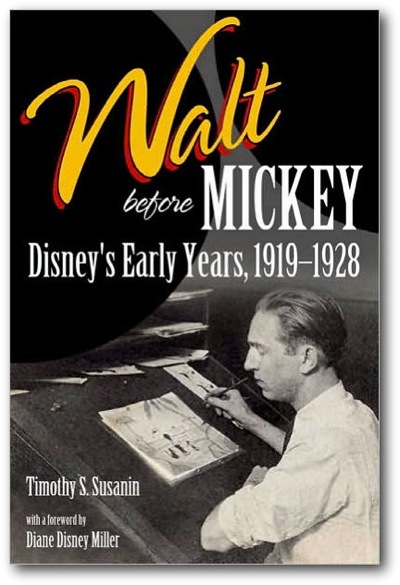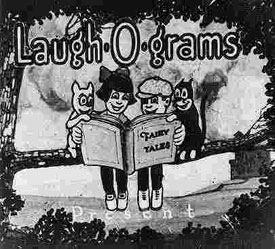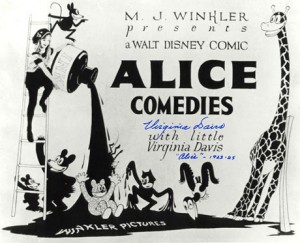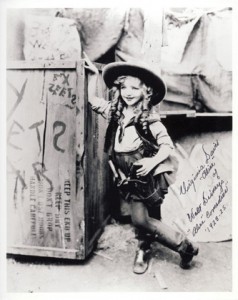Click here to print
Walt Disney Before Mickey Made Him
posted May 31, 2011

The photo on the cover is of 20-year old Walt animating the Laugh-O-gram Fairy Tale, "Jack, the Giant Killer," at the Laugh-O-gram Films studio in the McConahy Building in Kansas City, Missouri, in the fall of 1922.
In Walt Before Mickey: Disney’s Early Years, 1919-1928 (University Press of Mississippi), Timothy S. Susanin relates the great animator and filmmaker’s life before 1928, when he released Steamboat Willie, the film that secured his reputation and was the first Disney Studio cartoon with synchronized sound, and with Mickey Mouse.
Susanin, the general counsel of a Fortune 500 company when he’s not exploring Disney, focuses on Disney’s work in advertising and commercial art in Kansas City after serving in France in World War I, and before his more-famous period as the creator of Mickey and his friends. The book recounts the great animator’s years of struggling with, failing at, and eventually mastering the art and business of animation. From the age of 17, Disney worked in various venues and studios, refining his later, Disney style. He had served in the Red Cross in France after World War I, then returned to his native Kansas City to work in advertising and commercial art. He set up four studios – Kaycee Studios, Laugh-O-gram Films, Disney Brothers Studio, and Walt Disney Studio. He created such series as the Laugh-O-Grams, one-minute topical cartoons for a local theater owner. Soon after, with borrowed money, he created the Oswald the Rabbit series, and then the Alice Comedies, which combined live action and animation. Then he moved to Los Angeles to join his brother, Ray, and the rest would become history.
Susanin uses company documents, private correspondence between Walt and Roy, contemporary newspaper accounts, and new interviews with Disney’s associates to provide a detailed sense of this part of Disney’s career. In her preface, Diane Disney Miller, the filmmaker’s oldest daughter, writes: “Tim has done an amazing job of chronicling the lives of the people in that period who affected Dad’s life. His research brought out the fact that some of Dad’s early benefactors were his neighbors on Bellefontaine, people who had seen him grow up and were aware of his industrious nature. Dad, it appears, was never shy about asking for a loan. But he was diligent about repaying it . . .
“Tim continues on for several more years, all exciting for the brothers and their wives, though not without periods of anxiety. He ends with the loss of Oswald the Rabbit and the creation of Mickey Mouse. Dad’s telegram to Roy as he, with my mother, were about to depart New York for home was ‘Leaving tonight stopping over KC arrive home Sunday morning seven thirty don’t worry everything OK will give details when arrive – Walt.’ He didn’t mention the fact that they had lost Oswald. They would need a new plan, a new character. Roy, who had been caring for my parents’ chow dog Sunnee, recalls that nothing was said until Roy inquired, ‘Tell me about it, kid . . . What kind of deal did you make?’ ‘We haven’t got a deal,’ Dad cheerfully replied. ‘We’re going to start a new series.'”
Susanin answered some questions about his project.
Before Disney settled on Mickey Mouse as his first major character, in the years you write about, from 1919-1928, he made a series of films with a different main character, a little girl named Alice. Can you tell me a little about those films – what kind of films they were, how many of them Disney made, and why he decided not to continue with these “Alice Comedies”?
 Actually, Mickey was not Walt’s first major character. There was a recurring cast comprised of a girl, a boy, a dog, and a cat, in the Laugh-O-gram Fairy Tales he made at Kaycee Studios and Laugh-O-gram Films in 1921 and 1922. His Alice Comedies series, 1924-1927, starred Alice (live-action) and a cat named Julius (animated). He created and animated a series called Oswald the Lucky Rabbit from 1927-28 (other animators continued that series after Walt had a falling out with the distributor in 1928). As to your question about the Alice Comedies: The series featured a live-action girl named Alice and her adventures in a cartoon world. She was seen with many animated animals, but her co-star was a black cat named Julius. There were 50 Alice shorts (one reel subjects) made between 1923 and 1927 (the first was not released until 1924). Over the course of the series, four young girls played Alice. In the earliest episodes, live-action sequences featuring Alice and her friends (played by children from the neighborhood surrounding the Kingswell Avenue location of the Disney Brothers Studio) opened and closed the reels. After a number of episodes, these live action sequences were dropped. The Alice Comedies ended in 1927, when Universal asked Walt’s distributor, the M.J. Winkler firm out of New York, to provide it with a series based on a rabbit. The Winkler company asked Walt to create and animate the new series, and the start of the Oswald series caused the end of the Alice series.
Actually, Mickey was not Walt’s first major character. There was a recurring cast comprised of a girl, a boy, a dog, and a cat, in the Laugh-O-gram Fairy Tales he made at Kaycee Studios and Laugh-O-gram Films in 1921 and 1922. His Alice Comedies series, 1924-1927, starred Alice (live-action) and a cat named Julius (animated). He created and animated a series called Oswald the Lucky Rabbit from 1927-28 (other animators continued that series after Walt had a falling out with the distributor in 1928). As to your question about the Alice Comedies: The series featured a live-action girl named Alice and her adventures in a cartoon world. She was seen with many animated animals, but her co-star was a black cat named Julius. There were 50 Alice shorts (one reel subjects) made between 1923 and 1927 (the first was not released until 1924). Over the course of the series, four young girls played Alice. In the earliest episodes, live-action sequences featuring Alice and her friends (played by children from the neighborhood surrounding the Kingswell Avenue location of the Disney Brothers Studio) opened and closed the reels. After a number of episodes, these live action sequences were dropped. The Alice Comedies ended in 1927, when Universal asked Walt’s distributor, the M.J. Winkler firm out of New York, to provide it with a series based on a rabbit. The Winkler company asked Walt to create and animate the new series, and the start of the Oswald series caused the end of the Alice series.
 How many Alice films did he make, and what became of them? Are they well preserved and archived? Where?
How many Alice films did he make, and what became of them? Are they well preserved and archived? Where?
Forty of the 50 Alice shorts are known to exist. Some are owned by the Disney company; others are in private collections, here and abroad. I viewed some at the Library of Congress and the Museum of Modern Art. The best place for a listing of the Alice shorts (and where they may be found) is the book, Walt in Wonderland, by Merritt and Kaufman.
The Walt Disney Treasures collections series issued seven of the Alice films on DVD. Where did those come from, and have more been issued, or are others slated for issue?
I do not know if the Disney Treasures collection will do another Alice-based release. To the best of my knowledge, Disney has not announced the release of more.
Disney made other pre-Mickey films, too, right? Can you tell me a little about those – the Oswald the Lucky Rabbit films, for example. And the “Newman Laugh-O-Grams”? And what became of them?
You are correct. See my answer to number one above for the details. The Newman Laugh-O-Grams were cartoons made for a local theater in Kansas City in early 1921. Walt, who then worked at a film advertising company called the Kansas City Film Ad Company, made these cartoons after work. He would animate them in the evenings in his father’s garage behind the Disney family home in Kansas City, Missouri. A few of these cartoons exist, and can be found on certain Disney DVDs. (The endnotes to my book cite to the DVDs where I found such cartoons).
Have any pre-Mickey Disney films gone missing? Is it clear how many were made, and what might have become of them?
 Some of the Newman films, and a Kacyee Studios series called Lafflets, no longer exist. (See the Epilogue of my book for a summary of the state of each series today). All seven Laugh-O-gram Fairy Tales exist (some were just found this year – see David Gerstein’s Ramapith Prehistoric Pop Culture Blog and its October 14, 2010 story on recently found Laugh-O-grams). As mentioned above, 40 of 50 Alices survive. The Oswald series appeared into the 1930s, but Walt’s connection to it ended after its first season, which was comprised of twenty-six shorts made in 1927 and 1928. Thirteen of those survive.
Some of the Newman films, and a Kacyee Studios series called Lafflets, no longer exist. (See the Epilogue of my book for a summary of the state of each series today). All seven Laugh-O-gram Fairy Tales exist (some were just found this year – see David Gerstein’s Ramapith Prehistoric Pop Culture Blog and its October 14, 2010 story on recently found Laugh-O-grams). As mentioned above, 40 of 50 Alices survive. The Oswald series appeared into the 1930s, but Walt’s connection to it ended after its first season, which was comprised of twenty-six shorts made in 1927 and 1928. Thirteen of those survive.
Is active searching under way to unearth other early Disney material, and how often is anything discovered?
I do not know what efforts the Disney company or the Walt Disney Family Foundation (which runs the Walt Disney Family Museum in San Francisco) are undertaking.

Virginia Davis Young, one of four Alices in the Disney series. (The copyrights of images on this page, other than the book cover, above, are presumably owned by their publishers or creators. Use of scaled-down, low-resolution versions is to provide critical commentary on them, not solely for illustration, under US copyright law provisions for fair use.)
For that matter, what is the overall situation with respect to the preservation and reissue of post-Mickey films?
The Disney company has an extensive Film Library which I imagine is responsible for the post-Mickey works.
What led Disney to switch from his earlier characters to Mickey and co.?
The last chapter of my book explains in great detail – informed by Walt’s letters home to Roy – how Walt lost the Oswald series to an unscrupulous distributor named Charlie Mintz during negotiations for season two in New York City in early 1928. The Disney-Pixar movie entitled Up made reference to Mintz’s role as a real live Disney antagonist by featuring a villain named Charles Muntz.
Printed from Moving Image Archive News: https://www.movingimagearchivenews.org
URL to article: https://www.movingimagearchivenews.org/walt-disney-before-mickey-made-him/
Click here to print